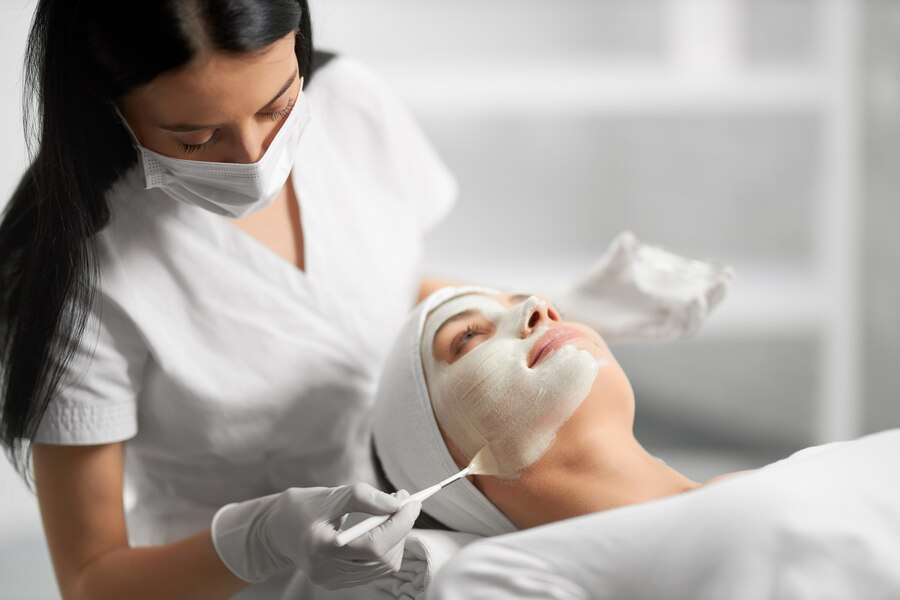The Science Behind Facial Treatments

The Science Behind Facial Treatments
In our quest for flawless, radiant skin, the world of facial treatments beckons with promises of rejuvenation, revitalization, and unparalleled beauty. Yet, amidst the plethora of creams, serums, and procedures, lies a deeper understanding rooted in scientific principles. Welcome to a journey where we peel back the layers of skincare, uncovering the intricate science behind facial treatments.
In this blog series, we delve into the mechanisms driving skincare innovations, exploring the biological processes that govern our skin’s health and appearance. From the molecular level to clinical applications, we’ll unravel the mysteries behind popular treatments, shedding light on their efficacy and safety.
Join us as we navigate through the dynamic landscape of skincare science, debunking myths, exploring breakthroughs, and empowering you with knowledge to make informed decisions about your skincare regimen.
Whether you’re a skincare enthusiast, a beauty professional, or simply curious about the science behind the glow, this series is your gateway to understanding the fascinating world of facial treatments.
The Physiology of Skin: Understanding the Foundation
The skin, our body’s largest organ, serves as a dynamic interface between our internal environment and the external world. Comprising multiple layers with distinct functions, such as the epidermis, dermis, and subcutaneous tissue, understanding its intricate physiology is fundamental to effective skincare.
The epidermis acts as a barrier, protecting against environmental aggressors, while the dermis provides structural support and houses essential elements like blood vessels and nerve endings. Beneath lies the subcutaneous tissue, responsible for insulation and cushioning.
Delving into the complexities of skin physiology unveils its remarkable ability to regenerate, adapt, and respond to various stimuli, laying the groundwork for tailored treatments that address individual needs.
Cellular Renewal: Exploring the Mechanisms of Exfoliation
Cellular renewal, a fundamental process in skin maintenance, involves the shedding of dead skin cells and the generation of new ones. Exfoliation accelerates this turnover, revealing fresher, brighter skin underneath.
Mechanistically, exfoliants work by breaking down the bonds between dead skin cells, facilitating their removal. Physical exfoliants utilize abrasive particles to slough off debris, while chemical exfoliants, such as alpha and beta hydroxy acids, dissolve the bonds holding dead cells together.
Understanding these mechanisms allows for the selection of exfoliation methods tailored to individual skin types and concerns, promoting smoother texture, improved tone, and enhanced product penetration.
Hydration Dynamics: Unraveling Moisture Retention Strategies
In the pursuit of supple, hydrated skin, understanding the intricate dynamics of moisture retention is paramount. Our skin’s ability to retain moisture is influenced by various factors, from environmental conditions to intrinsic biological processes. Delving into hydration dynamics reveals a multifaceted approach to maintaining optimal skin hydration levels.
- Barrier Function: The skin’s outermost layer, the stratum corneum, plays a crucial role in preventing moisture loss. Enhancing this barrier function through proper skincare routines and barrier repair ingredients such as ceramides and fatty acids helps retain moisture within the skin.
- Humectants: Hyaluronic acid, glycerin, and urea are examples of humectants that attract water molecules to the skin, increasing hydration levels. Incorporating products containing these ingredients can effectively boost moisture retention.
- Occlusives: Emollients and occlusive agents form a protective layer on the skin’s surface, sealing in moisture and preventing transdermal water loss. Ingredients like petrolatum, shea butter, and mineral oil act as occlusives, promoting long-lasting hydration.
- Hydration from Within: Hydration isn’t solely dependent on topical products; maintaining adequate hydration levels internally by drinking water and consuming hydrating foods contributes to overall skin health and moisture retention.
Understanding these moisture retention strategies empowers individuals to tailor their skincare routines effectively, ensuring that hydration remains a cornerstone of their skincare regimen.
Antioxidants and Free Radicals: The Battle for Skin Health
In the perpetual struggle for skin health, antioxidants emerge as formidable allies, combating the detrimental effects of free radicals. Free radicals, unstable molecules generated by factors like UV radiation, pollution, and stress, wreak havoc on skin cells, leading to oxidative damage, inflammation, and premature aging.
Antioxidants neutralize these rogue molecules, preventing oxidative stress and preserving cellular integrity. Common antioxidants found in skincare formulations include vitamins C and E, coenzyme Q10, and polyphenols derived from botanical extracts.
Harnessing the power of antioxidants through topical application or dietary intake fortifies the skin’s defense mechanisms, promoting resilience against environmental insults and sustaining a youthful, luminous complexion.
Collagen and Elastin: Building Blocks of Youthful Complexion
Collagen and elastin, two structural proteins abundant in the skin’s extracellular matrix, are indispensable for maintaining its firmness, elasticity, and overall youthful appearance.
Collagen provides structural support, imparting strength and resilience to the skin, while elastin confers elasticity, allowing it to stretch and recoil without sagging. However, aging, UV exposure, and lifestyle factors contribute to the degradation of these proteins, leading to wrinkles, sagging, and loss of volume.
Understanding the mechanisms underlying collagen and elastin synthesis and degradation facilitates the development of skincare interventions aimed at preserving their integrity and stimulating production, restoring skin firmness, and minimizing signs of aging.
Neurocosmetics: How the Brain Influences Skin Perception
The intricate interplay between the brain and the skin extends beyond mere physical sensation, encompassing emotions, perceptions, and even cognitive processes.
Neurocosmetics, a burgeoning field at the intersection of neuroscience and skincare, explores how the brain influences our perception of beauty and the efficacy of skincare products. Emotional states, stress levels, and even cultural influences can modulate our perception of skin health and attractiveness.
Moreover, sensory experiences, such as texture, fragrance, and packaging, can impact product efficacy and consumer satisfaction. By unraveling the neural mechanisms underlying these phenomena, neurocosmetics offers insights into novel approaches for enhancing skincare experiences and optimizing treatment outcomes.
Sun Protection Science: Safeguarding Against UV Damage
Sun protection is paramount for preserving skin health and preventing a myriad of UV-induced damage, including sunburn, premature aging, and skin cancer. Ultraviolet radiation, comprising UVA and UVB rays, penetrates the skin, generating reactive oxygen species and triggering DNA damage and inflammation. Sunscreens, formulated with UV filters that absorb or reflect UV radiation, serve as the cornerstone of sun protection.
Broad-spectrum formulations offer protection against both UVA and UVB rays, while antioxidants fortify the skin’s defense mechanisms against oxidative stress. Understanding the intricacies of sun protection science empowers individuals to adopt comprehensive photoprotection strategies, minimizing sun-induced skin damage and maintaining a youthful, radiant complexion.
The Role of Hormones: Impact on Skin Balance and Harmony
Hormones wield profound influence over skin physiology, dictating its structure, function, and response to internal and external stimuli.
Estrogen, progesterone, testosterone, and cortisol orchestrate various processes, including sebum production, collagen synthesis, and immune function. Hormonal fluctuations, such as those occurring during puberty, menstruation, pregnancy, and menopause, can manifest as acne, hyperpigmentation, or dryness.
Moreover, hormonal imbalances contribute to skin conditions like acne vulgaris, hirsutism, and melasma. Understanding the intricate interplay between hormones and skin health informs targeted interventions, such as hormone replacement therapy or topical treatments, aimed at restoring balance and harmony to the skin.
Peptides and Growth Factors: Unlocking Regenerative Potential
Peptides and growth factors, bioactive molecules abundant in the skin, play pivotal roles in orchestrating cellular communication, proliferation, and tissue repair. Peptides, composed of amino acids, function as signaling molecules, modulating processes like collagen synthesis, wound healing, and inflammation.
Growth factors, secreted by various cell types, regulate cell growth, differentiation, and migration, facilitating tissue regeneration and remodeling.Harnessing the regenerative potential of peptides and growth factors through topical application or advanced skincare formulations accelerates wound healing, enhances skin elasticity, and diminishes fine lines and wrinkles.
Understanding the mechanisms governing their actions enables the development of targeted interventions, unlocking the skin’s innate capacity for renewal and rejuvenation.
Advanced Delivery Systems: Maximizing Treatment Efficacy
The efficacy of skincare formulations hinges not only on the potency of active ingredients but also on their ability to penetrate the skin barrier and exert their therapeutic effects at the desired site of action.
Advanced delivery systems employ innovative technologies to enhance the bioavailability, stability, and targeting of active compounds, ensuring optimal efficacy and minimal side effects. Liposomes, nanoparticles, and micelles encapsulate active ingredients, facilitating their transport across the skin barrier and protecting them from degradation.
Additionally, carrier systems like liposomes can target specific skin layers or cells, maximizing treatment efficacy while minimizing systemic exposure. Understanding the principles of advanced delivery systems empowers skincare formulators to design tailored solutions that address individual needs and optimize treatment outcomes.
As we conclude our exploration into the intricate science behind facial treatments, we’ve unveiled the underlying mechanisms that dictate skin health and vitality. From understanding the physiology of skin to harnessing the regenerative potential of peptides and growth factors, we’ve delved into a realm where science meets skincare.
Now armed with knowledge, it’s time to take proactive steps towards nurturing your skin. Whether you’re revamping your skincare routine, considering professional treatments, or simply incorporating science-backed principles into your daily regimen, remember that informed choices pave the path to radiant, youthful skin.
For those seeking expert guidance and personalized treatments, American Laser Med Spa in Midland, TX, offers cutting-edge solutions tailored to your skincare needs. Contact them today at 432-689-7546 or email Midland@americanlaser-medspa.com to embark on your journey to glowing, healthy skin.
Let’s together embrace the science behind facial treatments and unlock the secrets to a luminous complexion. Stay tuned for more insights, tips, and discoveries to elevate your skincare journey.







